Over the past several years there has been an increased interest in micro machining technology that has captured the imagination of every manufacturing and industry segment; from aerospace, medical appliance and the automotive world, the potential for product miniaturization continues to grow and while posing numerous technical challenges.
In response to this continued miniaturization, companies are developing new technologies to meet the unique challenges posed by micro manufacturing and must develop appropriate machining systems to support this growth.
The manufacture of miniature parts is not new. Many companies have used various machining technologies such as EDM and laser to produce micro details for many years. The difference today is the shear volume of products that require micro machining. The accelerated rate of change is unbelievable.
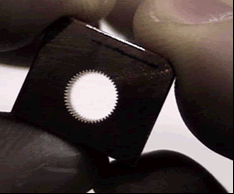 New miniature products are changing how we view the world. Many manufacturers’ are developing micro machining technologies and techniques to support this growth. Companies are looking for parts having feature sizes of less than 100 microns, or somewhat larger than a human hair.
New miniature products are changing how we view the world. Many manufacturers’ are developing micro machining technologies and techniques to support this growth. Companies are looking for parts having feature sizes of less than 100 microns, or somewhat larger than a human hair.
At this scale, the slightest variation in the manufacturing process caused by material or cutting tool characteristics, thermal variations in the machine, vibration and any number of minute changes will have a direct impact on the ability to produce features of this type on a production scale.
In response to this continued miniaturization, companies are developing new products and technologies to meet the unique challenges posed by micro manufacturing.
These types of tolerances are mind boggling and would have been unthinkable just a few years ago. Talk of using end mills of 0.002" (50 µm) diameter and EDM wire diameters of 0.00078" (20 µm), or electrodes smaller than a few tenths is becoming more commonplace. The application micro-meso machining technologies are being employed in the manufacture of a wide variety of products and devices.
- Medical Components
- Micro Molds
- Electronic Tooling
- MEMS (Micro-Electrical-Mechanical-System)
- Fluidic Circuits
- Micro-Valves
- Particle Filters
- Subminiature Actuators & Motors
The trends in the ultra high accuracy and micro-miniature manufacturing fields require a fresh look at new machine technology and process techniques.
DEFINING MICROMESO MACHINING TECHNOLOGY
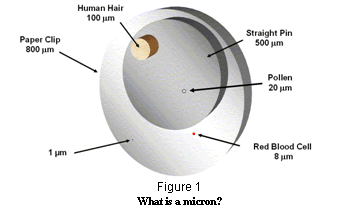 The term micro machining has a variety of definitions, depending upon whom you are speaking too.
The term micro machining has a variety of definitions, depending upon whom you are speaking too.
Micro machining simply means small or miniature to many of us in manufacturing.
Those in academia and research define Micro in a very literal way, or 10-6 , in other words, as one-millionth of a meter. (A micron n: a metric unit of length equal to one millionth of a meter [syn. – micrometer. Origin - Greek m kro-, from m kros, small] quite literally as 106 (mm)],
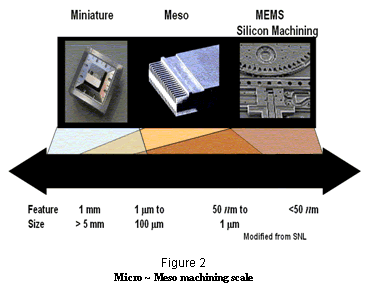 We need to further define, for purposes of clarification, what all of this means to us in manufacturing based on the part or feature size.
We need to further define, for purposes of clarification, what all of this means to us in manufacturing based on the part or feature size.
Figure 2 illustrates the range of part and feature size machining capability. Parts with machined features below <0.004" (100 µm) fit into the middle (e.g. - meso) range of manufacturing.
The chart below provides a basic reference of the micro machining range of various machining technologies.
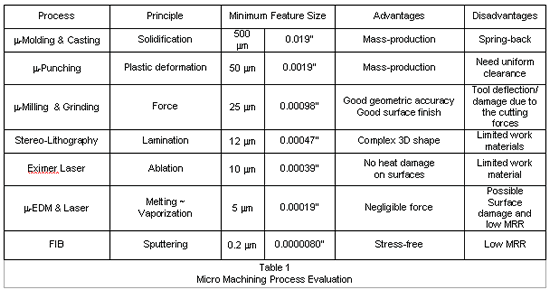
CHALLENGES OF MICRO MACHINING SYSTEM DEVELOPMENT
Maintaining control of all of the machining variables, including the machine tool, work and tool-holding, the environment, cutting tools or electrodes will all have a huge cumulative effect on the end result.
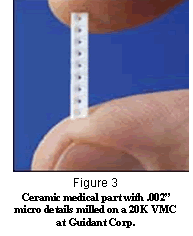 With such small parts and feature sizes, accuracy takes on a completely new meaning. For example, ±0.0002 tolerance is very different if the feature being machined is 0.200" vs. only 0.002" in size. For this reason, it becomes necessary to re-think the meaning of precision.
With such small parts and feature sizes, accuracy takes on a completely new meaning. For example, ±0.0002 tolerance is very different if the feature being machined is 0.200" vs. only 0.002" in size. For this reason, it becomes necessary to re-think the meaning of precision.
There are several key areas of concern when machining details this small.
1. Environmental changes that impact Accuracy; process predictability and repeatability
2. Vibration (Internal and External)
3. Part Management
4. Cutting Fluids and Fluid Dynamics
Machine resolution, control, construction and ancillary tools all become much more critical to the success in producing micro parts.
Besides being able to machine micro features and parts, simply handling micro parts and tools will pose unique challenges. This unfortunately would have an impact on the repeatability of a process that has a desired tolerance of less than a micron.
USING NANOMETER RESOLUTION
Although high resolution feedback systems have improved accuracy and eliminate servo drift there is more that need to be done. Figure 4 demonstrates the difference in servo drift between 1µ and 0.1µ feedback resolution.
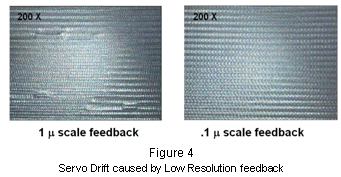 It is also no longer good enough to have feedback systems and resolutions only in the micron range. When machining in the micro machining range, sub-micron control and feedback systems are necessary.
It is also no longer good enough to have feedback systems and resolutions only in the micron range. When machining in the micro machining range, sub-micron control and feedback systems are necessary.
Due to this cumulative effect of errors, a good rule of thumb is that the systems employed for manufacturing should be 10 times more accurate than the repeatable tolerance desired. This would mean that to achieve a ±0.00020" (±5 micron) tolerance would require a system that would provide at least 0.000020" (0.5 micron) precision.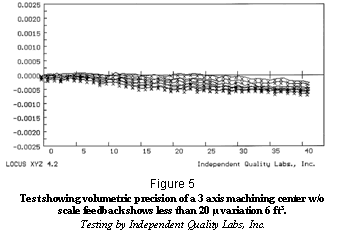
Feedback resolutions in the 10 50 nanometer range are now available to improve "resolution" accuracy on new machine tools, however this does not necessarily make a machine accurate. Resolution is the digital accuracy of the machine tool and does not correct for alignment problems.
Alignment is critical in producing accuracy, and depending upon the number of axes that are combined in a system, the perpendicularity, parallelism and straightness of the positioning axes to each other are just as critical to precision as the resolution. Figure 5 shows the volumetric accuracy of a Vertical Machining Center.
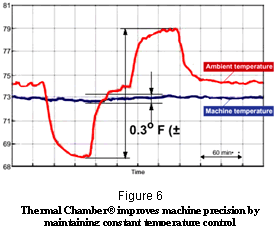 ENVIRONMENTAL CONTROL
ENVIRONMENTAL CONTROL
We all know that the shop environment can change during the day. Even a single degree of change will affect accuracy when machining in the submicron level.
Simply monitoring the room is not enough. Structural changes caused by temperature variations are affected by the mass of the machine. The rate of change (convection) will vary from system to system based on mass.
For this reason, it makes sense to incorporate a machine thermal enclosure to maintain the machine in its own controlled environment.
In Figure 6, demonstrates the thermal stability that can be achieved with a multi-layer thermal enclosure that combines insulation with a layer of air. Air temperature monitoring and flow is controlled to maintain uniform temperature distribution.
Direct monitoring of minute temperature variations that occur in the machining system can be accomplished through the use of monitors (thermisters) embedded in the machine frame or casting.
SUBMICRON TOOLING
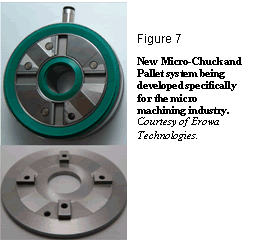 Precision work and tool (electrode) holding systems capable of positional repeatability in the 1 micron range have been commercially available since the late 1980’s. Originally designed for the EDM industry, these systems are highly reliable, even in the harsh EDM environment, and are now found on virtually every type of machining system.
Precision work and tool (electrode) holding systems capable of positional repeatability in the 1 micron range have been commercially available since the late 1980’s. Originally designed for the EDM industry, these systems are highly reliable, even in the harsh EDM environment, and are now found on virtually every type of machining system.
From machining centers to grinders, to coordinate measuring machines, these holding systems can be found in every type of manufacturing environment.
Due to the demands for better accuracy required for Micro Machining, new innovations in tooling with submicron repeatability are necessary.
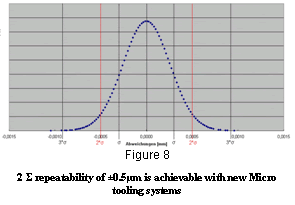 Figure 8 (Courtesy of Erowa Technologies) demonstrates the advances in workholding technology being developed for the micro machining market.
Figure 8 (Courtesy of Erowa Technologies) demonstrates the advances in workholding technology being developed for the micro machining market.
According to the manufacturer, this new tooling system is twice as accurate as previously available systems.
MICRO MILLING
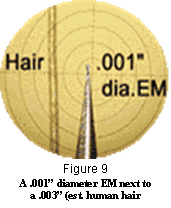 Micro machining using conventional technologies, such as milling present unique challenges in manufacturing. Cutting forces and tool pressures when using micro tools create a whole new realm of problems. Any variation in axis position during the cut can be disastrous.
Micro machining using conventional technologies, such as milling present unique challenges in manufacturing. Cutting forces and tool pressures when using micro tools create a whole new realm of problems. Any variation in axis position during the cut can be disastrous.
The spindle must be stable and minimize thermal expansion, tool change variation and vibration. Any vibration or run-out at the tool tip will adversely influence the surface finish and accuracy.
One of the problems associated with micro milling is the amount of foce associated with removing material at the particulate level.
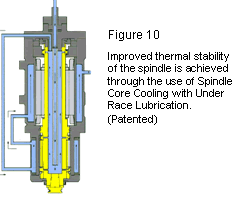 One solution developed several years ago is a direct tool-change type spindle. By eliminating the use of a tool holder, it is possible to reduce total run-out caused by tool holder variation and is ideal for micro machining due to the elimination stack up issues.
One solution developed several years ago is a direct tool-change type spindle. By eliminating the use of a tool holder, it is possible to reduce total run-out caused by tool holder variation and is ideal for micro machining due to the elimination stack up issues.
Whether using a direct type, or one that uses a tooling system such as HSK, the spindle must be stable and minimize thermal expansion, tool change variation and vibration.
The method of cooling and lubricating the spindle will have a direct impact on spindle growth and movement during the machining process. The Inside – Out cooling provided by Spindle Core Cooling takes advantage of centrifugal force to move cooling fluid though the spindle.
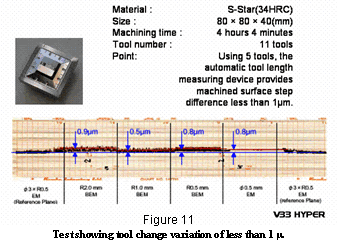 Traditional laser tool measurement systems have shown some limitations when measuring cutting tools below .020" (0.5 mm) common when machining micro parts.
Traditional laser tool measurement systems have shown some limitations when measuring cutting tools below .020" (0.5 mm) common when machining micro parts.
New hybrid ATLM systems combines the benefits of touch and non-contact measuring in order to verify tool tip position in the micron range regardless of spindle thermal expansion.
Figure 11 demonstrates the submicron precision obtained over a four hour period even when completing multiple tool changes.
MICRO WIRE EDM
ED machining has been a mainstay of manufacturing for more than 50 years, providing unique capabilities to the job shop and manufacturer alike.
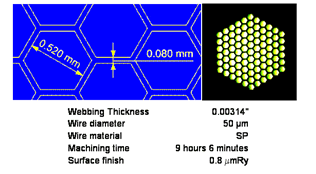 Miniature parts and components have been produced for many years using the non-contact capabilities of EDM systems. In fact, Life magazine published a photograph in the early sixties of a series of micro holes that were EDM’d through a needle and spelled out the magazines name "LIFE".
Miniature parts and components have been produced for many years using the non-contact capabilities of EDM systems. In fact, Life magazine published a photograph in the early sixties of a series of micro holes that were EDM’d through a needle and spelled out the magazines name "LIFE".
The ability to automatically wire thread and machine parts with a 20 µ (0.00078") wire and achieve corner radii of less than 15 µ would have been unthinkable just a few years ago.
The problems of small hole threading and hole proximity can now be conquered.
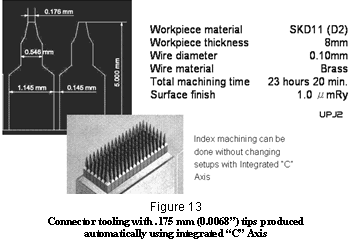 A key to this technology is the horizontal inclination of the Wire and the utilization of air and vacuum rather than a fluid to thread the Wire. This is a radical departure from conventional designs. Machining in the horizontal plane provides several advantages including an integrated "C" axis for work holding and automated part loading with slug removal systems that improve automation.
A key to this technology is the horizontal inclination of the Wire and the utilization of air and vacuum rather than a fluid to thread the Wire. This is a radical departure from conventional designs. Machining in the horizontal plane provides several advantages including an integrated "C" axis for work holding and automated part loading with slug removal systems that improve automation.
The open design of a V type wire guide improves automatic Wire threading reliability. The guide controls the cutting tool and must therefore be highly accurate. The V type guide provides 3-Point contact with the wire for superior wire alignment.
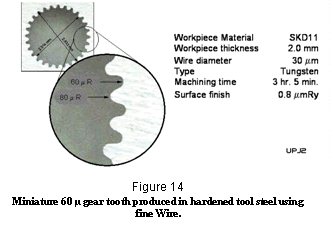 As discussed earlier, an environmental system for precise temperature control (within ± 0.5º C) must be used when machining ultra fine details.
As discussed earlier, an environmental system for precise temperature control (within ± 0.5º C) must be used when machining ultra fine details.
Lastly, an Oil dielectric instead of de-ionized water in order to provide -
- A smaller spark gap due to the added insulation strength of Oil.
- Oil produces superior surfaces due to the quenching characteristics
- Oil Eliminates the problems of rust during long unattended operation
MICRO EDM SINKING
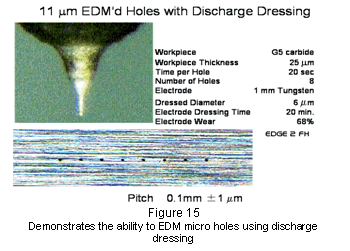 Today’s CNC die sinking EDM system is much more capable than their manual predecessors for conventional mold manufacturing and micro machining of complex parts for a wide range of applications.
Today’s CNC die sinking EDM system is much more capable than their manual predecessors for conventional mold manufacturing and micro machining of complex parts for a wide range of applications.
When talking about machining in the micron range it is necessary to look at machine design and construction, as well as the ability to produce parts efficiently in a production environment. Successful EDM’ing requires minute orbital motion in order to achieve the speed and surface finish to make micro machining economical.
Machining of micro holes has become an immensely important micro machining application. From micro start holes for newer wire EDM’s to production ED drilling of small holes, EDM’ing has produced tremendous results. Figure 11 pictures a Silver Tungsten electrode that was ED dressed in the EDM machine to 6-µm diameter for producing an 11 µm (0.00043") diameter hole.
Holes having an L to D of 100:1 are possible by incorporating a "High Pressure" dielectric pumping (>800 psi) system and using micro tubing down to .1mm. holes.
High-pressure seals in the rotating head and high precision rotation are necessary as well.
CONCLUSIONS
Micron and sub-micron manufacturing requirements will continue to grow offering unique challenges and immense opportunities to a wide group of manufacturers. The designs and construction of many machine tools, work and tool holders, cutting tools and electrodes will naturally evolve as greater demands are placed on them when machining these miniature parts. Many of the challenges will evolve around economically controlling the micro manufacturing process. Many of these systems would not have been developed had it not been for the demands of industry for more and more capability.
For these systems to perform successfully in the "Real World" requires cooperation and imagination on everyone’s part.
In the end, it is the user that challenges the expertise of the OEM to develop effective micro machining systems, processes and applications techniques to support the business.
The UPJ-2 Horizontal Wire EDM, V22 High Precision VMC and EDGE2-FH Micro EDM system will highlight Makino’s "MicroMachining" exhibit at the EDM Pavilion of the 2004 International Manufacturing Technology Show (IMTS) at McCormick Place in Chicago, Illinois, September 8 through 15. It will be on display at Booth #4110 in Hall D. Visitors may also get additional information at the main Makino Booth #8400 in Hall A of the South Building.
John Shanahan is the Product Manager for Makino, Inc. (Mason, OH) and is responsible for the technical marketing for all EDM products. Besides holding several technical EDM sales and marketing positions, he has also managed an EDM job shop on the West Coast. He has published several articles and spoken at a large number of seminars on topics including automation, EDM’ing, High Performance Machining and Die/Mold production processes through-out the United States and Canada.
Reprinted by permission of EDM Today

